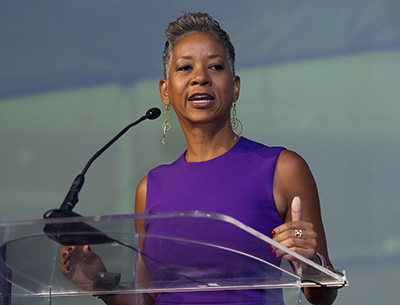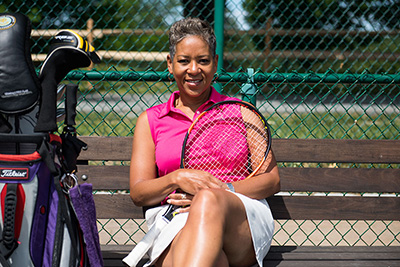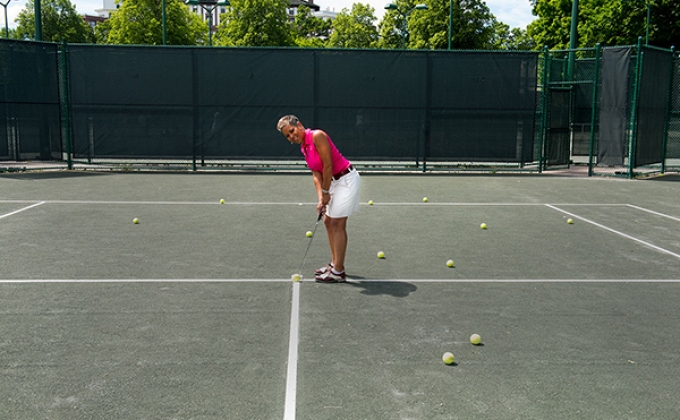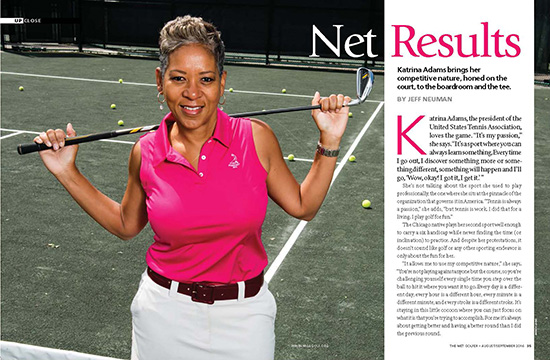Expanded Content: Katrina Adams
Katrina Adams: Outtakes
When writing a profile, an interviewer has to leave out a lot of interesting information gleaned over the course of an extended conversation. So it was when we interviewed Katrina Adams, president of the United States Tennis Association. Some of what we didn’t have room for in the magazine appears below, in quotations condensed and edited for readability.
On her growing up in tennis in Chicago:
I started when I was six, as the tagalong sister [her brothers were attending a Boys Club summer program featuring tennis]. After being persistent and begging, the instructors and the Boys Club supervisors and my parents let me in and I fell in love with it right away. I was very fortunate that one of the coaches took me under his wing and started playing with me once a week. He got me into programs and then the following summer I got into a more constructive program and the rest is history.
[This was] on the west side of Chicago, Garfield Park is where I started. And then I started playing at Lake Meadows Tennis Club, which is in Lake Meadows near Southside right off of Lake Shore Drive – 31st and Lake Shore Drive. And then indoors, I started playing at Midtown Tennis Club once a week and Harvey Tennis Club out in Harvey, Illinois. Lake Meadows was a public facility. Midtown was a private club. Harvey, Illinois, was part of a Holiday Inn out there so I guess it was private, but the tennis coach at the time had a relationship there. Hyde Park Racquet Club opened in ’79. I started in ’75 so that ultimately became my home base club, from ’79 until whenever I left Chicago. I played all over. I played at Tam Tennis Club which is in Niles, Illiniois. I joined a program up there, Rod Schroeder Tennis Academy, started working with the head coach, Rod Schroeder. So all around Chicago I was playing tennis. Wherever I could get on the court and whatever benefitted me to developing my game further is where I went.
That summer [when I was six] was the first time we had ever been introduced to tennis. I had never seen it before, and the middle of that summer is when Arthur Ashe actually won Wimbledon, so I was able to kind of identify with the sport at that particular moment watching him on television. To say, “Wow, you can do this on television!” I still had no idea or thought process then, it was just another sport. I had played all sports, and that was just a new one I had picked up. But it was something I had an ownership of -- I really fell in love with the feel of hitting the ball, controlling my own destiny. I was very competitive and that was my motivation.
On whether her race was an issue as she was learning tennis:
I was seven, so that didn’t matter to me. I didn’t understand what I didn’t know. When I was playing at Midtown, there were very few people of color that were there. They may have had one, maybe two teaching pros, and then you had your upper echelon professionals, doctors, lawyers of color that were playing there at the time. But Alan Schwartz saw that I had potential and loved the sport, so whenever I wanted a court I was able to get a court there, which was great. But I started playing tournaments a year or two later in the local areas from all Metropolitan suburbs of Chicago. As a kid, you don’t know any different. I wasn’t taught to know anything different. We’re all people. So if there were some uncomfortable situations, my dad would always protect me from it. So I never directly had any issues, which is how it should be.

On deciding to become a pro player:
I didn’t get into the sport to be a professional tennis player. Every weekend or two weekends out of every month I was playing in some local tournament; I just loved to compete, so for me it was about what was at hand for the next tournament and walking away with the big trophy and not the little trophy. Even going to nationals, it just wasn’t a part of my thought process. I think as I got older, you know, 14, 15, 16… I graduated from high school at 16, so there were people in the country who thought I would turn pro at that point but I still didn’t understand what that meant. I knew you could play pro, but I didn’t understand the process.
My parents were teachers, so I knew I was going to college. That wasn’t even an issue. I mean, there wasn’t even a doubt. And I wanted to go to college. I ended up going to Northwestern; I was recruited, went there on scholarship and played. While I was in college, my coach at the time thought I was going to turn pro after the first year, which was not my intent. I had set goals early on [when I was] around 12 years old, and part of it was if I was to turn pro, I would go to college for at least two years. I think that’s because that’s what I had heard at the time, not because I knew what was customary.
As I was going into my sophomore year, my coach was like, “I think you’re ready.” At the end of my sophomore year, we won the NCAA doubles and then I would have been returning #3 in singles. I took the fall quarter off [and] I played as an amateur. I said, “You know what, I know I’ve played tennis all day every day every summer for the last 10 years; I don’t know if I want to do this outside of the summers at that level, traveling around and playing. Let me try to do it in the fall, and see how it goes; if I don’t like it I’ll come back to school, keep my scholarship, and we’ll never have the conversation again. If I do well then maybe I’ll turn pro in January, but at least give me that opportunity.” I had a really good fall, ended up being like 104 in the world with direct entry into the Australian Open. So for me, at that time, okay, yeah, I can turn pro. Turning pro at 300 in the world was not going to accomplish anything. 200 in the world was not going to accomplish anything. 100 in the world, okay I can now travel on the Tour, improve my ranking, earn a living and go from there. That was my process. I’m very proud of that process, that I didn’t do it prematurely. Not to say that had I had done it earlier it couldn’t have been better, but I think the path that I chose was the proper one. I was able to mature more as an individual in school. I had fun in college, got an education, so it was good, and it helped prepare me to be who I am today.

On playing other sports growing up:
The only organized sport I played was basketball, and that was very briefly. I was on the team at my high school for the first semester, first ten weeks, but the practices were conflicting with tennis and the coach was like, “You’re a tennis player; go play tennis. You’re a good basketball player -- I love your passion, your athleticism, you’re a great student of the game, but you’re a tennis player.” I had two older brothers, most of my cousins were boys, so I was always around boys and I was always playing sports. From softball in our backyard to throwing a football to playing strike ‘em out (where I was a pitcher throwing into a square box with an ‘X’ on it)… Those skills early on, when I got onto the tennis court, helped me be a very good tennis player because I knew how to throw, so I could serve. I had great eye-hand coordination from playing softball. I could throw a football with a spiral, so that’s the serving motion. There were a lot of things I already had from a very young age that just translated right into playing tennis, so it was really fun.
On learning golf while being a professional tennis player:
A lot of tennis players play golf, so it was kind of an easy transition. You actually have a lot of down time when you’re on the road, so it became kind of a pastime. We had a series of tournaments about four or five weeks in a row where you were in golf environments during tennis tournaments: We played Indian Wells, we played in Miami, and then it was Hilton Head, Amelia Island, and maybe one other tournament in there. So all of these environments provided opportunities for you to go and play. So you would play for five weeks, then you wouldn’t play for five months. And when I say play for five weeks, you may play once that week, but still it’s an opportunity to get out or go to a driving range or do something. I Iived in Houston and started meeting some friends that played golf all the time, so whenever I could get away and go play, even if it was just nine holes… The guys knew I had great hand-eye coordination and would tell me what to do. I would do it, and they were like, “Oh my god, you’re an unbelievable student! You do exactly what I tell you to do!” I was just a visual learner. I used to rock back up until literally about five years ago where I now have a lot more rotation. But I didn’t know anything different because I’d never been told anything different and I was getting good results.

On her favorite places to play:
I’ve been very fortunate, played all over the world. In this country, I got to play Pinehurst last year for the first time, shot 81 there that was pretty impressive. I’ve played Doral, I’ve played Torrey Pines, Oakmont, Oak Hill, Lancaster Country Club, I got to play that this year. Here in New York: Westchester Country Club, Winged Foot, Mount Kisco Country Club, Quaker Ridge, Whippoorwill, I’ve gotten around. I’ve been lucky, as I meet people that invite me to play their clubs. I’ve played a lot of the Troon courses out in Arizona. I was in Paris recently, I played Golf De Chantilly and Golf De Saint Germain, and I think they’re two of the top four courses in France. I’m scheduled to play Royal Wimbledon in two weeks when I head over there. I’ve played Saint Andrews; I played Kingsbarn, the Old Course, and the Jubilee over there at Saint Andrews. That was a golf trip with three of my girlfriends about three years ago. They said that was the first time in 70 years they had summer. For the four days we were there, blue skies. We packed all our rain gear and sweaters, and you literally were wearing short sleeves and I had to buy short sleeve shirts because I ran out of them. But from a historical nature, it doesn’t get much better than that.
The first day was frustrating. We played Jubilee the first day, which is a lot dryer than the other courses. On a 140-yard shot, you literally only wanted to hit it 110 yards. But it took me 16 holes to finally figure out, okay, you’re not hitting seven iron, you’re hitting nine iron or pitching wedge to release and roll. And that’s part of being a student of the game. You can’t be frustrated because you’re not being rewarded. A good shot is knowing you need to hit a 110 yard shot for a 140 yard release. It was fun. The Old Course was the last one we played, so I was much better on that third day than I was on the first day. You just figure it out.
On her role models as she was growing up in tennis:
I had a lot of older players that would play with me, that wanted to play with me, and it was really cool. “Older” meaning I was eight and they were 18. There were players Sylvester Dorsey, Kendall Dogan, Darryl Dogan, Helyn Edwards, Pam Triche… these were all people I grew up with in Chicago. When you’re eight, you look at these people like your big brother and big sister, and now your friends. Lisa Thomas was a very good tennis player who was an exceptional basketball player, so when the first women’s professional basketball league was developed in the late ‘70’s, she was a professional basketball player. You kind of idolize that and say, “Wow!” Your coaches… people that brought you up and mentored you… the first coach I had was Tony Fox who took a chance and pulled me under his wing but took me to his mentor when I got to a certain level and he realized he couldn’t offer me what I needed. He took me to Chris Scott, who was my ultimate coach who really developed me after that. Then I went to my next level coach Rod Schroeder that I mentioned, and to Bill Simms who was the coach at University of Chicago. So everyone kind of had a hand in molding me or helping me develop, not only as a tennis player but as an individual. A young guy, Tyron Mason, who’s like my big brother -- he’d pick me up, take me to practice; as I got older, he’d loan me his car secretively, ‘cause he had a sports car. It was great. Mel Phillips -- another guy that would just come pick me up and hit balls with me. The list is endless. I would say as a professional, I really admire Arthur Ashe coming up for what he had accomplished. Having had the chance to meet him and get to know him a little bit -- not enough -- his life was cut too short, too soon. Zina Garrison took me under her wing on the tour. When I first came onto the tour, she was top ten in the world and she was teaching me the ropes. It’s an amazing. Billie Jean King is one of my greatest idols and a great friend today. Understanding what she did and the sacrifices that she made for women in general, not just for tennis, but on the humanity side and for sport -- for girls, it was incredible. Anytime I’m sitting across for her, it’s hard not to be enamored and just listen. The list is endless, but I would say my number-one idols were my parents because they sacrificed a lot to provide me an opportunity to do what I enjoyed, not knowing where that was going to go.
On her favorite tennis venues:
The U.S. Open, of course! I would say of the Grand Slam, each of the four have their own character, their own reputation, their own feel. You start in the beginning of the year with Australia. My first year on Tour was the first year it was at its current location. It was basically walking distance from downtown, everything was convenient, but it was more about the personalities of the people in the country that were fun, easy-going, relaxed. It was a great atmosphere. The French Open: back in the late ‘80s, ‘90s, they weren’t the friendliest towards Americans, not so much the tournament but the city. You’re in Paris, it’s Paris, you enjoy it, but I didn’t really have a great time until probably the last ten years, when I started to enjoy going to Paris. But I would say during the competitive years, it was okay, but it’s Paris -- how could you not like it? But I didn’t like it because it was my worst surface and I didn’t do very well, so that had something to do with the mentality of it as well. Wimbledon: well, it was Wimbledon, it was probably the only place I actually ironed my outfit before going onto the court because you just felt you had to be pristine and perfect. I think every grain in the grass was perfect in the first few days of the tournament. I loved grass - it suited my game. I had my best results of a major at Wimbledon, so it’ll always have a special place [for me]. Things you didn’t like, you’d just accept because it was Wimbledon. And then you have the Open, that’s just loud, vivacious, boisterous – showtime! The city that never sleeps is just an unbelievable atmosphere, but the most pressure was also at the U.S. Open because you had a lot of friends or families or fans here, and you wanted to win or do your best for them. So there was a lot of pressure from that. And then there were a few Tour events that I enjoyed playing: La Costa in California was a fun one, Miami was a fun one, Indian Wells was a fun one. I loved playing in Hilton Head. In Europe we had an indoor tournament in Zurich -- I enjoyed playing in that one. There was a tournament in Berlin that I had fun playing in. And just because you go time and time again, you start to build relationships with tournaments. Probably my most favorite indoor tournament was in Stuttgart, because of the relationships building. All around the world I had favorite spots.
On the strengths of her golf game:
I’m a professional athlete, so mostly just being able to focus on what’s at hand is a strength. I’m a long ball hitter, so my drive is obviously my strength and I’m pretty accurate -- staying in the fairway from there. My short game… I don’t practice enough, so it could be a lot better. Some days my putter’s hot and most days it’s not. I’m working on my approach shots more and my fault is alignment. So I’ll have the right club, right distance and I’m off. It’s literally just alignment. I don’t practice, I just don’t. I’ve never really practiced. I don’t spend time on the range. So I would say the next couple years I’ll start to make some of that practice time in so I can really enjoy it that much more. For me, it’s just a couple tweaks here and there. You hate when you leave six birdie putts out there, or six strokes, or six pars out there because the ball is short, left, or right, or rings around.
This is a sport where you can always learn something. For me, with tennis, I’ve been to the pinnacle, there’s not much more I can learn. I’m obviously learning every time I watch the higher-level players, but it’s more on the fitness than on a mental side. In golf, I’m still learning, so it makes it fun. Every time I go out, I discover something more or something different on the course.

